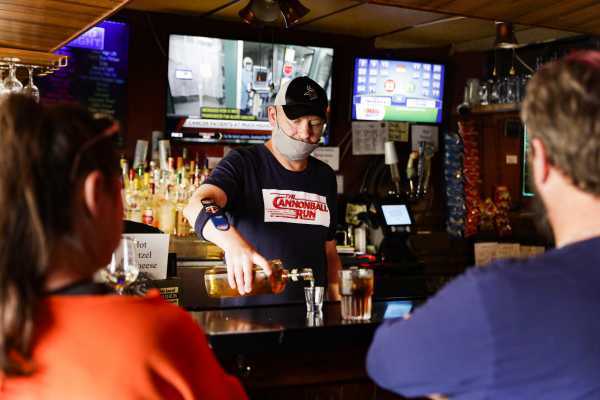
4 reasons state plans to open up may backfire — and soon
States are opening up their economies. Scientists fear this isn’t going to end well.
By
Brian Resnick@B_resnick
May 9, 2020, 9:20am EDT
Share this story
-
Share this on Facebook
-
Share this on Twitter
-
Share
All sharing options
Share
All sharing options for:
4 reasons state plans to open up may backfire — and soon
-
Reddit
-
Pocket
-
Flipboard
-
Email
On Monday, Missouri will allow concerts to resume for the first time since the state’s stay-at-home order started at the beginning of April. Yes, concerts, where people usually pack together, breathing the same air. Apparently, the Missouri government believes it will be safe if people attending stand 6 feet apart.
It’s not just concerts: Under Gov. Mike Parson’s direction, all businesses in the state can resume operations, provided that employees and customers keep some distance between themselves. (The exception: St. Louis will remain in lockdown.) Meanwhile, the number of daily new positive cases is still trending upward in Missouri.
What’s happening in Missouri is beginning to happen in many parts of the country even though most states still fail, as this New York Times interactive shows, to meet the White House’s criteria for doing so: having a downward trajectory of cases over a two-week span, along with increased testing capacity.

It’s understandable that states want to open up. The pandemic has resulted in a painful and scary economic downturn; unemployment has spiked to 14.7 percent. There’s an emotional toll to social distancing, too: How many people haven’t seen their families in months, are severely lonely, or are desperate for physical contact?
But is the public health situation really all that different than when lockdowns began in March? According to epidemiologists, no. Although the situation varies from place to place, now, in general, doesn’t appear to be the best time for Americans to return to close proximity to one another. There are three main reasons:
Epidemiologists’ predictions for what will happen next are grim. “If we open up and, and do exactly what we were doing in March, we’re going to see a huge increase in cases,” Eleanor Murray, an assistant professor of epidemiology at the Boston University School of Public Health, says. “We’ll go back to that same exponential trajectory.” That, in turn, will further strain and potentially overwhelm the capacity of a health care system that’s already been dealt brutal financial and psychological blows from the first wave.
It’s possible, based on new projections from Columbia University, that states opening up will lead to an increase of 10,000 new cases or more each day by June.
It might not come to pass. But the risk is there. “What we’re going to see is on an unfortunate natural experiment going on,” Jeffrey Shaman, a Columbia University infectious disease modeler, says. “For the states that are loosening the restrictions and reopening, we’re going to see if they’re able to do it without having the virus blow up in their face. … basically, they’re playing Russian roulette.”
1) America is still in the peak of the epidemic. Cases have, at best, plateaued.
It’s true that case counts are decreasing in some places — most notably in New York, the hardest-hit state in the country; New Jersey; and Connecticut.
But overall, “cases have increased and reached a plateau,” says Stephen Kissler, who designs mathematical models on disease outbreaks at Harvard. “That’s hiding a lot of changes. … And so really, we’re in this phase of sort of trying to play whack-a-mole with the pandemic, and that’s going to continue for some time.”

Easing restrictions during a plateau means releasing people into an environment where “there are more people around with infection now than ever before,” Murray says. “Instead of starting from one or two cases in each city [as might have been the case in March], we’re going to be starting from hundreds of cases or thousands of active cases in each city.”
On March 20, there were around 5,000 confirmed daily new cases of Covid-19 in the United States (though, the real number was likely much higher). Since early April, there have been at least 20,000 to 30,000 new cases in the US reported every day as the virus replicates in more and more humans.
“People keep talking about the second wave and we’re not through the first wave,” Tara Smith, a Kent State epidemiologist, says. Cases “haven’t gone down significantly anywhere except, maybe, New York City.”
Yet the White House’s plan for opening things back up requires a “downward trajectory of documented cases within a 14-day period.” We’re not anywhere close to that nationally, or locally in most places.
It is possible that the rate of new cases is slowly starting to subside. But even so, case counts are still very high.
Infectious disease modelers Teresa Yamana, Sen Pei, and Jeffrey Shaman at Columbia University recently ran three projections that are helpful in thinking through what could happen in the coming weeks.
In one scenario, there’s no change: States don’t open up, and we keep what we’re doing now. Nationally, cases and deaths decrease from the current plateau.
In a second scenario, there’s a 10 percent increase in the contact rate in all the counties and cities in states that are opening up. That means, on average, Americans see 10 percent more people than they have been during lockdown. Cases would then jump to 43,353 cases per day at the end of June, up from about 28,000 cases per day in early May, Yamana, Pei, and Shaman find.
The third scenario is similar to the second, but there’s an additional 10 percent increase in the contact rate each week after opening, “meaning that people start to say, okay, things are all right, [and] they get more and more complacent,” Shaman says. And then, according to the model, new cases jump to 63,330 cases per day.
In the second and third scenarios, death counts might actually decrease across the country in May. But a new wave of death would be brewing, and the toll would rebound by June, increasing throughout the month.
These projections are merely best guesses as to what could happen. It’s hard to know what people will actually do — will they increase their contacts by 10 percent or more? They might not. But who wants to be in the position to find out?
2) Many, many people are still vulnerable
Another important reason this isn’t going away: Even though there have been more than a million confirmed cases in the US, overall, very few people in the country have been infected. “It’s not like we’re well on our way to accruing some sort of population-level immunity,” says Natalie Dean, a biostatistician at the University of Florida.
There have been some serological studies trying to assess how many people in a given area have antibodies (molecules the body creates in response to an infection) for the virus that causes Covid-19.
These studies “haven’t been always of the best quality,” Dean says (more on that here), “but in the end, pretty consistently they’re telling us we’re still in the single digits.” That is, still under 10 percent of the United States has been infected. This picture looks different in harder-hit areas. In New York City, it’s possible as much as 21.1 percent of the population has gotten the infection, according to a serological survey conducted by the state.
Related
Lung scarring, heart damage, and anxiety: Some Covid-19 survivors face long-term complications
That sounds like a large percentage, and it is, but it’s not close to the level needed for herd immunity — when there are enough people with immunity that the contagion starts to naturally die out. “Around 60 percent [immune] roughly is when you might start to see changes,” says Caitlin Rivers, an epidemiologist at the Johns Hopkins Center for Health Security. “And we do not want to get there, just to be clear.”
It would take a long time to get there, too: One recent study in Science found it would take until 2022 if the US wanted to achieve herd immunity in a manner that would also prevent hospitals from being overwhelmed. And any path to herd immunity would involve many, many people dying.
Even if one city, or one community within one city, achieves herd immunity, it’s still not enough. The US a huge, sprawling nation. A pocket of herd immunity in Queens, New York, doesn’t help end an outbreak in Nebraska.
“My own estimate would be in the US that we probably have 10 to 20 million people who have been infected thus far,” Shaman says. “That’s not a huge amount.” There are 328 million people in the country, most of whom are still vulnerable.
3) The biology of this virus makes it formidable
A quick review of the basic reproduction number, or R0, for this coronavirus: Without interventions in place, each infected person can infect, on average, two or three others. That’s a recipe for exponential growth. “If it were left to its own devices, given its nature, and given how efficiently it transmits person to person, we would expect 50 to 70 percent of the world’s population to be infected within the span of one to two years,” Shaman says.
It has not been left to its own devices. We’ve been trying to contain it with good hygiene, quarantine, and social distancing. Still, this virus is a sneaky little bastard — it spreads silently and survives on some surfaces. It takes an average of five days for a person to show symptoms after being infected, but it can take up to 14 (most flu symptoms show themselves after one to four days). During that time, some people can spread the virus to others before they know they are sick.
This incubation period is enough to lure some communities into a false sense of security. Cases could go down, and any change in policy will not show up in infection rates (provided people are being tested) for a few weeks.
“It could be really terrible if we try to pretend that everything’s back to normal,” if initial social distancing gets cases down and we start to feel complacent, Sarah Cobey, a scientist who studies epidemics and immunity at the University of Chicago, says. The virus can kill between 0.5 and 1 percent of the people it infects. That figure, too, is both big and small. It’s big enough to cause a million deaths or more in the United States if precautions aren’t taken.
4) We don’t have plans in place to stop the spread — and to learn from reopenings
Lockdowns were always a blunt measure.
“We had to go that route because we didn’t have other tools in place,” Murray says. The outbreak was too widespread, and America’s capacities were too low, to aggressively test for the virus and trace the contacts of those it has touched. “What we should have been doing while we were in lockdown was building up that capacity. … I think what we’re seeing right now is that people are getting sick of lockdown, but [do we] have those other tools really ready to go?”
We do not. As of May 1, a Harvard analysis found that more than half of states are not doing enough Covid-19 testing to safely reopen. Without testing, we cannot know where the virus is and whom it may spread to. Testing is crucial to shift lockdowns into a smarter, more focused strategy: identifying all new cases, putting them in isolation, and then figuring out who may have been in contact with those people and putting them in quarantine.
“Experts say the US needs 500,000 tests a day, on the low end, to tens of millions, on the high end, to fully control the coronavirus outbreak,” Vox’s German Lopez reports. “Based on the COVID Tracking Project, the US has averaged about 260,000 tests a day — a little more than half the minimum — over the first week of May.” Also lagging: programs to train and deploy contact tracers, to make sure one case of Covid-19 doesn’t turn into thousands.
Testing isn’t just needed to diagnose the sick; it’s needed for surveillance and to answer important scientific questions.
It seems clear that when people are in confined indoor spaces with lots of people — like in meatpacking plants, dormitories, nursing homes, office buildings, or homeless shelters — the virus thrives. But what about in a small barbershop, where both the customers and the barber are wearing masks? It’s not without risk, but the risk is hard to quantify. As is the risk of transmission among children, and from children to adults.
As states open up, they’re essentially creating experiments to see which policies lead to new cases and which don’t.
Hopefully, scientists and local health departments will have the right studies in place to track the outcomes. “But what I’m really afraid of is that a lot of areas aren’t set up even to learn from their own mistakes and successes,” Cobey says. This work takes not just Covid-19 diagnostic tests but also after-infection tests to see if a person has developed antibodies to Covid-19.
“I am really fearful that by June 1 or June 15, after we’ve seen a couple weeks to a month of this [state openings], that our cases are going to be climbing — and even worse, that we might not see them because … we are maxed out with our testing capacity,” Smith says. The first sign that the openings have backfired might come when hospitals start seeing many severely ill people again — which means a significant new wave is already underway.
Potential for chaos abounds: An area can ease restrictions and, due to sheer luck (or seasonal factors mixed with luck), might not see an increase in cases. It could brag about its success. Then another area could adopt the same policies and be doomed.
The future is uncertain. But the choice to reopen, and when, is something we can control.
There’s a lot of uncertainty in the future. But we do have some control. Lifting social distancing restrictions now invites a new wave of infections. “We get to choose when the second wave happens,” Cobey says. Why choose now?
This is just the health case for not rushing to reopen. There’s also an economic one. If the US creates a situation where more people get sick in the next few weeks, leading the spikes, is that really going to save restaurants and small businesses — or just set them up for an even longer period of decline? On the other hand: Will people go out and patronize businesses again even if they are allowed? We’ll have to see.
Yes, the country can pursue a dual goal of protecting lives and protecting the economy. But opening too quickly may tip the balance too far in the direction of death and health system strain, without really helping the economy.
“We need to very clearly state our goals, and we need to be serious about that the fact that opening up our economy does come at the cost of a certain number of Covid illnesses which come with Covid deaths,” Kissler says. “There’s no good way about it.”
Support Vox’s explanatory journalism
Every day at Vox, we aim to answer your most important questions and provide you, and our audience around the world, with information that has the power to save lives. Our mission has never been more vital than it is in this moment: to empower you through understanding. Vox’s work is reaching more people than ever, but our distinctive brand of explanatory journalism takes resources — particularly during a pandemic and an economic downturn. Your financial contribution will not constitute a donation, but it will enable our staff to continue to offer free articles, videos, and podcasts at the quality and volume that this moment requires. Please consider making a contribution to Vox today.
Sourse: vox.com





